
How to Use 4 Channel Relay Module: Examples, Pinouts, and Specs
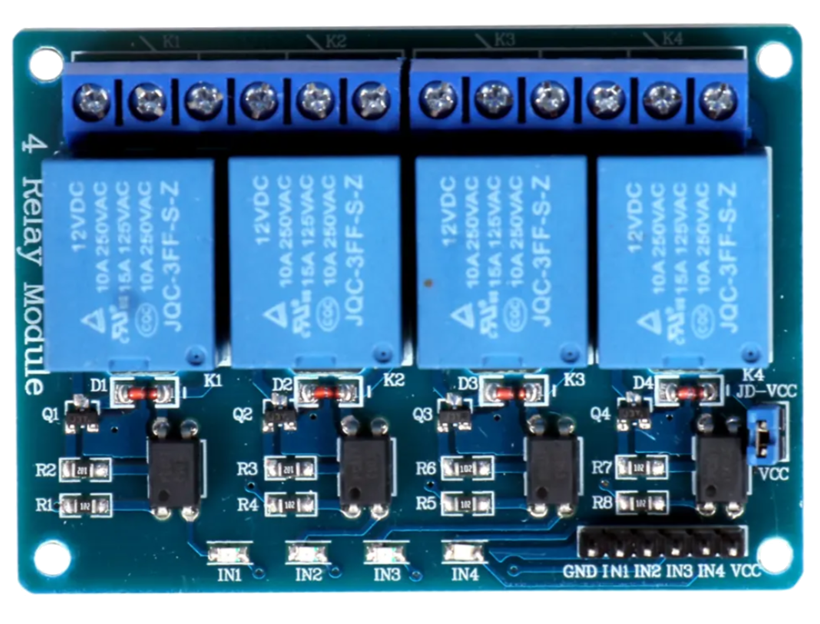
 Design with 4 Channel Relay Module in Cirkit Designer
Design with 4 Channel Relay Module in Cirkit Designer4 Channel Relay Module Documentation
1. Introduction
The 4 Channel Relay Module is an electronic component designed to control high-voltage devices using low-voltage signals. It features four independent relays, each capable of switching AC or DC loads. This module acts as an interface between microcontrollers (e.g., Arduino, Raspberry Pi) and high-power devices, allowing safe and efficient control of appliances, motors, lights, and other equipment.
Common Applications:
- Home automation systems (e.g., controlling lights, fans, or appliances)
- Industrial automation
- Robotics (e.g., controlling motors or actuators)
- IoT projects
- Smart energy management systems
The module is widely used in projects requiring the control of multiple high-power devices while isolating the control circuit from the load circuit.
2. Technical Specifications
Key Technical Details:
| Parameter | Specification |
|---|---|
| Operating Voltage | 5V DC |
| Trigger Voltage | 3.3V to 5V DC |
| Relay Type | Electromechanical SPDT (Single Pole Double Throw) |
| Maximum Load (AC) | 250V AC @ 10A |
| Maximum Load (DC) | 30V DC @ 10A |
| Isolation | Optocoupler-based isolation between control and load |
| Dimensions | ~75mm x 55mm x 20mm |
| Weight | ~60g |
Pin Configuration and Descriptions:
| Pin Name | Type | Description |
|---|---|---|
| VCC | Power Input | Connect to 5V DC power supply. Powers the relay module. |
| GND | Ground | Connect to the ground of the power supply or microcontroller. |
| IN1 | Control Signal | Input signal to control Relay 1. Active LOW (0V to activate, 5V to deactivate). |
| IN2 | Control Signal | Input signal to control Relay 2. Active LOW. |
| IN3 | Control Signal | Input signal to control Relay 3. Active LOW. |
| IN4 | Control Signal | Input signal to control Relay 4. Active LOW. |
| COM (x4) | Load Terminal | Common terminal for each relay. Connect to the load circuit. |
| NO (x4) | Load Terminal | Normally Open terminal. Load is connected when the relay is activated. |
| NC (x4) | Load Terminal | Normally Closed terminal. Load is connected when the relay is deactivated. |
3. Usage Instructions
Connecting the 4 Channel Relay Module:
Power Supply:
- Connect the
VCCpin to a 5V DC power source. - Connect the
GNDpin to the ground of the power source or microcontroller.
- Connect the
Control Signals:
- Connect the
IN1,IN2,IN3, andIN4pins to the digital output pins of a microcontroller (e.g., Arduino). - The relays are active LOW, meaning a LOW signal (0V) will activate the relay, and a HIGH signal (5V) will deactivate it.
- Connect the
Load Connections:
- For each relay, connect the load circuit to the
COM(common) terminal and either theNO(normally open) orNC(normally closed) terminal:- Use
NOif the load should be OFF by default and turn ON when the relay is activated. - Use
NCif the load should be ON by default and turn OFF when the relay is activated.
- Use
- For each relay, connect the load circuit to the
Example Circuit:
- Connect an Arduino UNO to control the relays.
- Use the
IN1toIN4pins to control four devices (e.g., lights or motors). - Ensure the load circuit is isolated from the control circuit.
Arduino Code Example:
The following code demonstrates how to control the 4 Channel Relay Module using an Arduino UNO:
// Define the relay control pins
#define RELAY1 2 // Relay 1 connected to digital pin 2
#define RELAY2 3 // Relay 2 connected to digital pin 3
#define RELAY3 4 // Relay 3 connected to digital pin 4
#define RELAY4 5 // Relay 4 connected to digital pin 5
void setup() {
// Set relay pins as OUTPUT
pinMode(RELAY1, OUTPUT);
pinMode(RELAY2, OUTPUT);
pinMode(RELAY3, OUTPUT);
pinMode(RELAY4, OUTPUT);
// Initialize all relays to OFF (HIGH state)
digitalWrite(RELAY1, HIGH);
digitalWrite(RELAY2, HIGH);
digitalWrite(RELAY3, HIGH);
digitalWrite(RELAY4, HIGH);
}
void loop() {
// Example: Turn relays ON and OFF with a delay
digitalWrite(RELAY1, LOW); // Turn ON Relay 1
delay(1000); // Wait for 1 second
digitalWrite(RELAY1, HIGH); // Turn OFF Relay 1
delay(1000); // Wait for 1 second
digitalWrite(RELAY2, LOW); // Turn ON Relay 2
delay(1000); // Wait for 1 second
digitalWrite(RELAY2, HIGH); // Turn OFF Relay 2
delay(1000); // Wait for 1 second
digitalWrite(RELAY3, LOW); // Turn ON Relay 3
delay(1000); // Wait for 1 second
digitalWrite(RELAY3, HIGH); // Turn OFF Relay 3
delay(1000); // Wait for 1 second
digitalWrite(RELAY4, LOW); // Turn ON Relay 4
delay(1000); // Wait for 1 second
digitalWrite(RELAY4, HIGH); // Turn OFF Relay 4
delay(1000); // Wait for 1 second
}
4. Important Considerations and Best Practices
- Power Supply: Ensure the module is powered with a stable 5V DC supply. Using a voltage higher than 5V may damage the module.
- Isolation: The module uses optocouplers for isolation. This ensures the control circuit is protected from high-voltage spikes in the load circuit.
- Load Ratings: Do not exceed the maximum load ratings (250V AC @ 10A or 30V DC @ 10A) to avoid damaging the relays.
- Inductive Loads: When controlling inductive loads (e.g., motors, solenoids), use a flyback diode across the load to suppress voltage spikes.
- Active LOW Logic: Remember that the relays are activated with a LOW signal (0V) and deactivated with a HIGH signal (5V).
5. Troubleshooting and FAQs
Common Issues and Solutions:
| Issue | Possible Cause | Solution |
|---|---|---|
| Relays not activating | Insufficient power supply | Ensure the module is powered with a stable 5V DC supply. |
| Relays activate randomly | Electrical noise or interference | Use decoupling capacitors near the power supply and control pins. |
| Microcontroller resets when relays switch | Power supply cannot handle the load current | Use a separate power supply for the relay module and microcontroller. |
| Load not turning ON/OFF | Incorrect wiring of the load circuit | Verify connections to the COM, NO, and NC terminals. |
| Relays stuck in one state | Relay damaged due to overcurrent or overvoltage | Replace the damaged relay module and ensure load ratings are not exceeded. |
FAQs:
Can I use the module with a 3.3V microcontroller?
- Yes, the module is compatible with 3.3V logic levels. However, ensure the
VCCpin is still powered with 5V.
- Yes, the module is compatible with 3.3V logic levels. However, ensure the
Can I control DC motors with this module?
- Yes, but ensure the motor's voltage and current ratings are within the relay's limits. Use a flyback diode to protect the circuit.
How do I know if a relay is activated?
- Each relay has an LED indicator that lights up when the relay is activated.
Can I use this module to control 220V AC appliances?
- Yes, but ensure proper insulation and safety precautions when working with high voltages.
This documentation provides a comprehensive guide to using the 4 Channel Relay Module effectively. By following the instructions and best practices, you can safely integrate this module into your projects.
Explore Projects Built with 4 Channel Relay Module
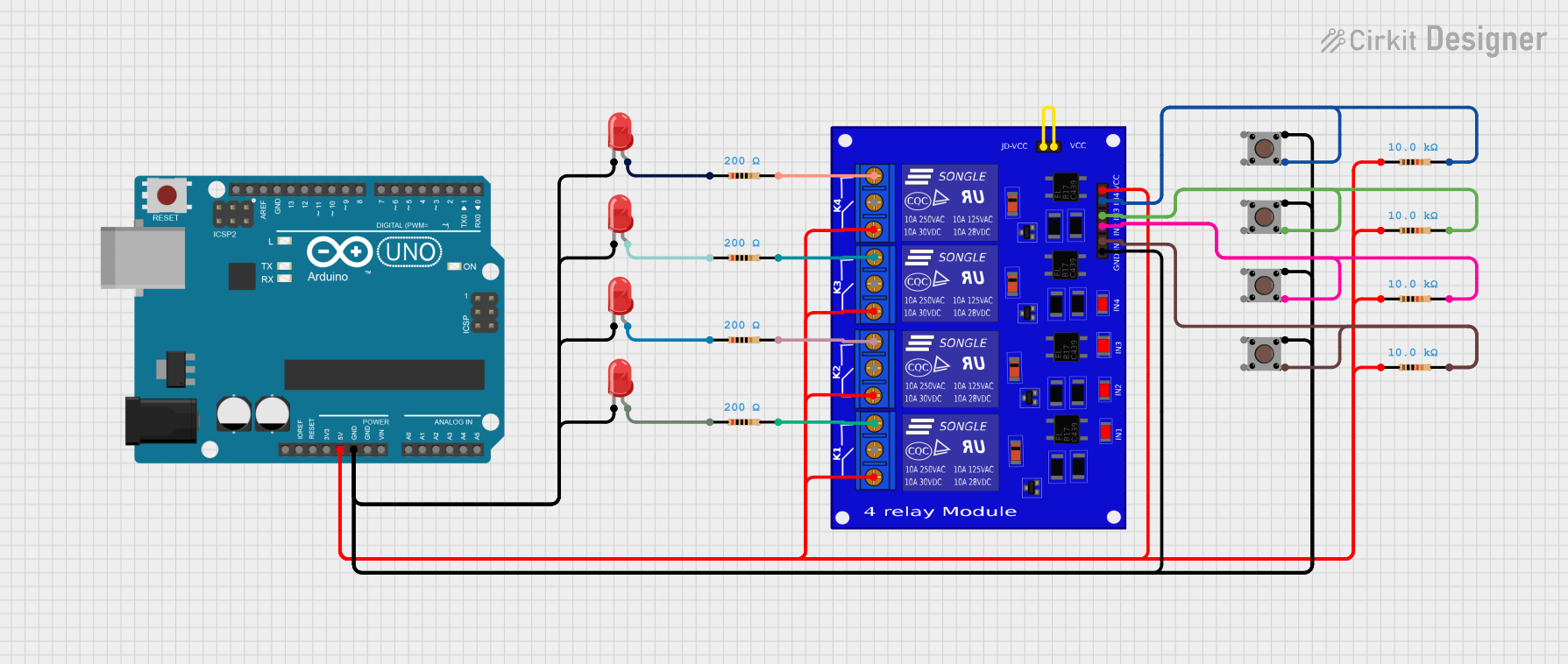
 Open Project in Cirkit Designer
Open Project in Cirkit Designer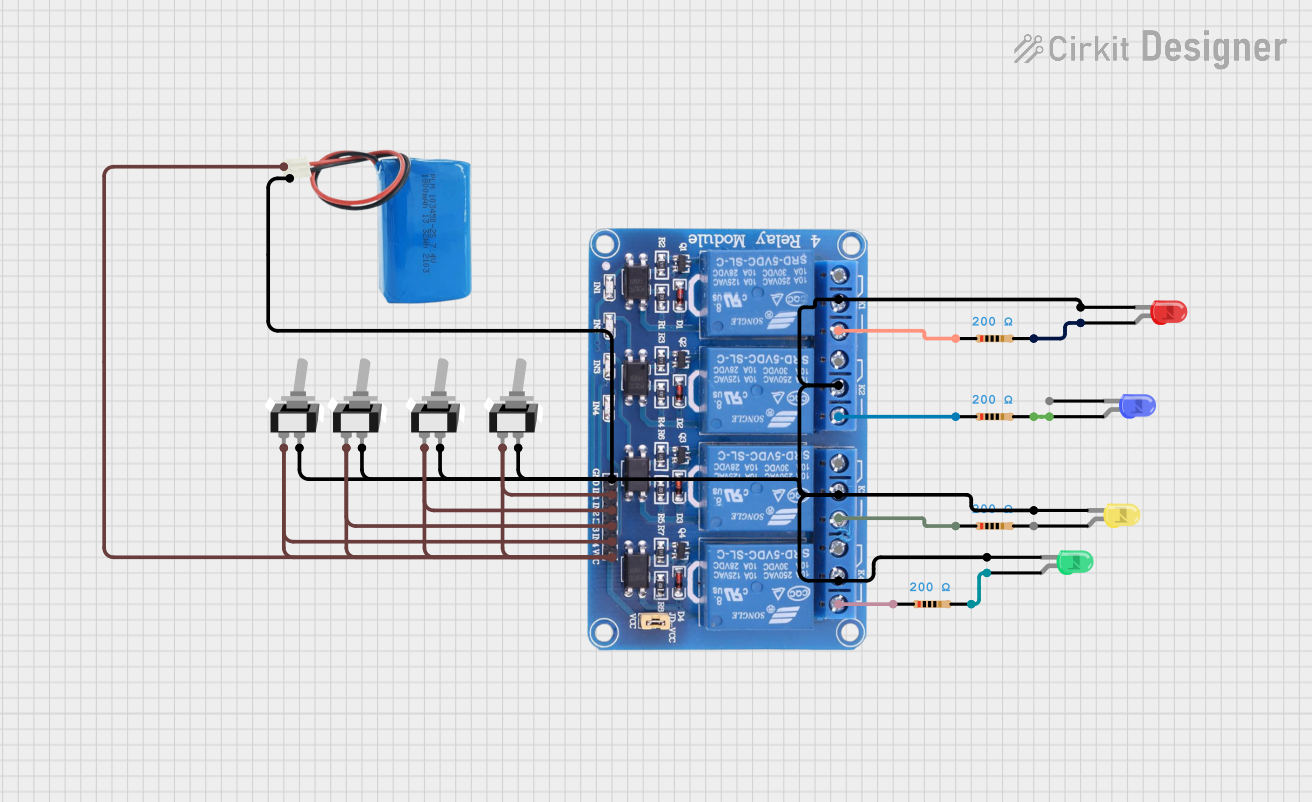
 Open Project in Cirkit Designer
Open Project in Cirkit Designer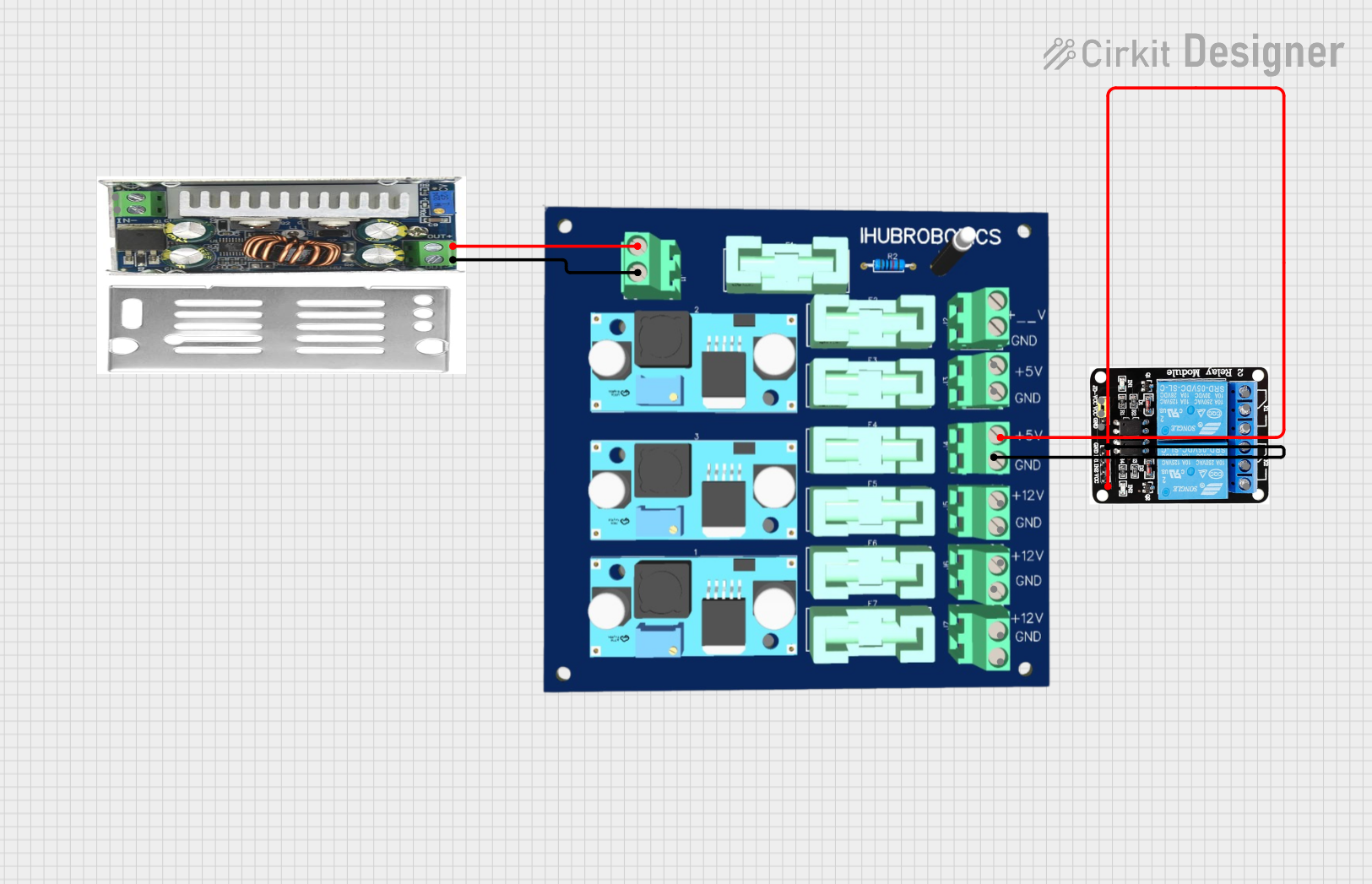
 Open Project in Cirkit Designer
Open Project in Cirkit Designer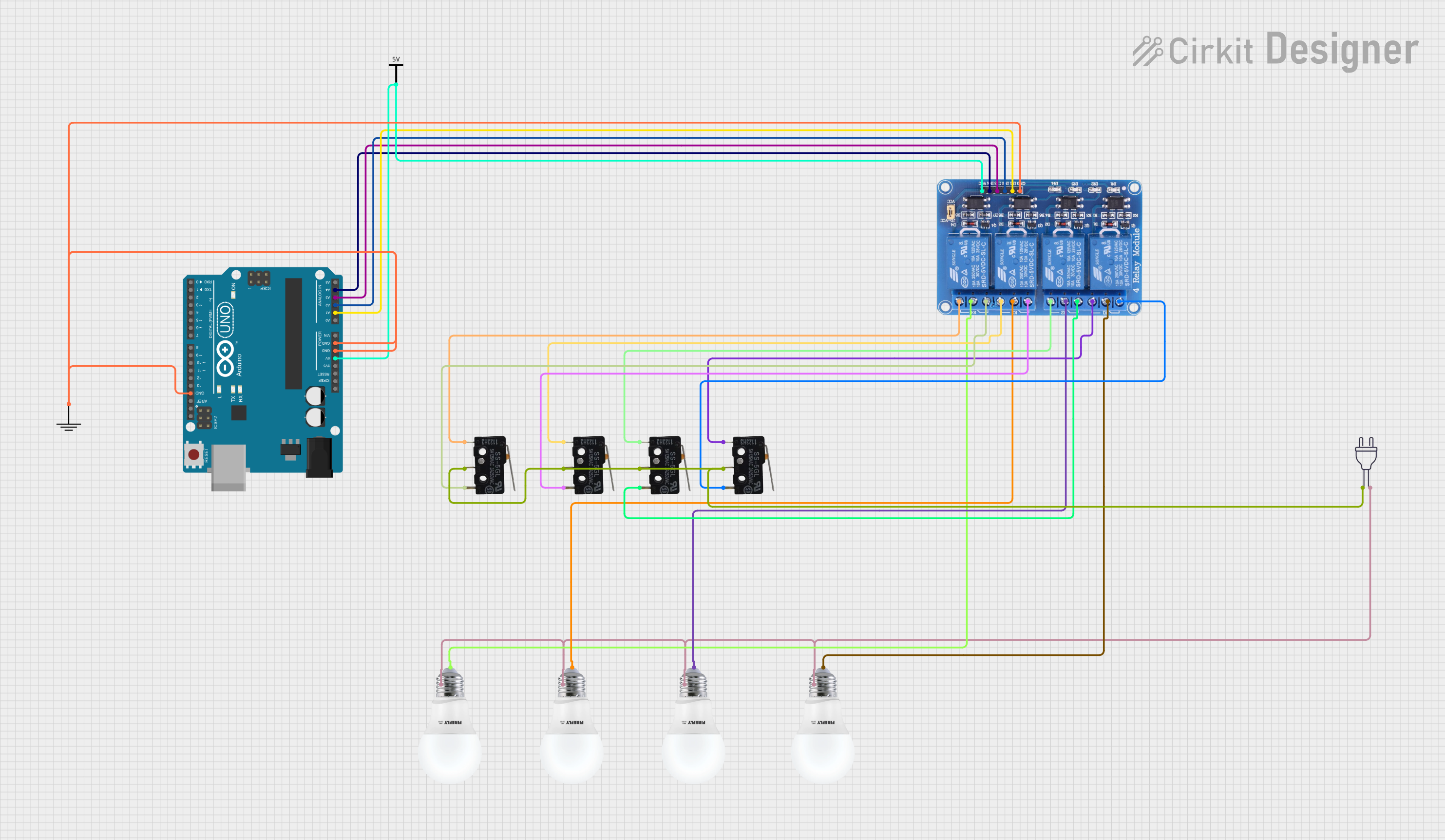
 Open Project in Cirkit Designer
Open Project in Cirkit DesignerExplore Projects Built with 4 Channel Relay Module

 Open Project in Cirkit Designer
Open Project in Cirkit Designer
 Open Project in Cirkit Designer
Open Project in Cirkit Designer
 Open Project in Cirkit Designer
Open Project in Cirkit Designer
 Open Project in Cirkit Designer
Open Project in Cirkit Designer